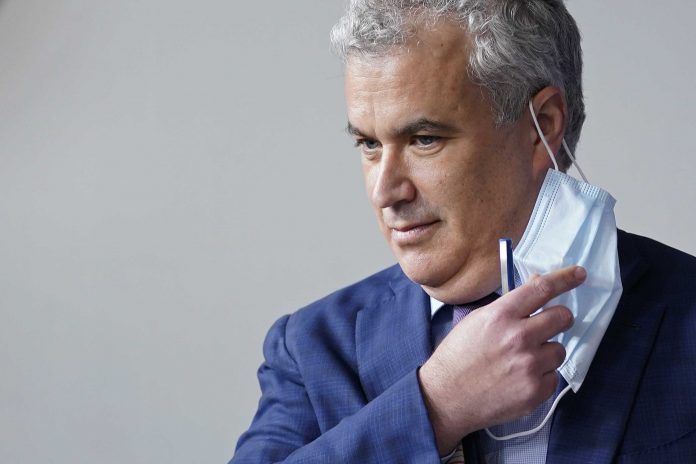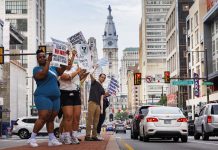
By ZEKE MILLER
Associated Press
WASHINGTON (AP) — With even Democratic states moving to roll back mask mandates, the White House said Wednesday it is beginning to prepare for a less-restrictive phase of the national COVID response in the face of growing impatience to ease up and turn toward post-pandemic normalcy.
President Joe Biden entered office promising to lead the nation out of the emergency phase of the pandemic, but it is state and local leaders who are stepping into leadership roles while Biden faces increasing scrutiny for his caution amid declining cases and rising public frustration.
The White House for the first time acknowledged movement in its planning on Wednesday, saying conversations have been underway privately for weeks.
White House COVID-19 coordinator Jeff Zients said officials are consulting with state and local leaders and public health officials “on steps we should be taking to keep the country moving forward.” His comments came as states have moved to ease their own restrictions.
Governors and local school officials have been pressing for clearer federal guidelines for easing or ending restrictions, but federal officials have been slow to preview potential changes. That’s led to a patchwork of local and state policies that differ widely from one place to the next.
“We are working on that guidance,” said Centers for Disease Control and Prevention Director Dr. Rochelle Walensky. “As we’ve been encouraged by the current trends, we are not there yet.”
The White House offered no timetable for the review or an indication of what it will recommend. Some critics say that’s not good enough.
“The tragic thing is that these are governors that would probably have followed the White House’s guidance,” said Dr. Leana Wen, a former Baltimore health commissioner. “They wanted CDC input and asked for it, but without a clear timeline, at some point they had to decide that they couldn’t wait any more. The fault is not theirs, but the CDC’s and by extension, President Biden’s, which, with each passing day, is making itself less and less relevant.”
Biden’s hesitance is driven in part by the sting of his fleeting “declaration of independence” from the virus last summer, which proved premature in the face of the delta and then omicron strains. Now, though, cases and hospitalizations from COVID-19 have dropped markedly since they peaked earlier this year amid the spread of the highly-transmissible omicron variant, and the vast majority of Americans are protected against the virus by effective vaccines and boosters.
Asked whether Biden appears to be out of touch with the country, White House press secretary Jen Psaki defended his caution. “As a federal government we have the responsibility to rely on data on science, on the medical experts,” she said.
“That doesn’t move at the speed of politics, it moves at the speed of data,” she added. Asked whether Americans should follow less-restrictive state or local rules or the stricter federal guidance, she repeated the White House’s daily counsel: “We would advise any American to follow the CDC guidelines.”
The CDC continues to recommend indoor mask wearing in places of “substantial or high transmission” of the virus, which as of Wednesday was all of the U.S. but 14 rural counties.
State and local leaders, nevertheless, have announced plans to ease virus restrictions in the coming weeks as omicron cases fall, citing the protections offered by vaccines as well as the increased availability of at-home testing kits and therapeutics for those who do catch the virus. Many of the restrictions eased last year, only to be reinstated as omicron swept the country.
Earlier this week, New Jersey, Connecticut and Delaware announced plans to lift statewide mask-requirements in schools. On Wednesday, state officials said Massachusetts will follow suit starting Feb. 28.
New York Gov. Kathy Hochul announced Wednesday that the state will end a COVID-19 mandate requiring face coverings in most indoor public settings, but will keep masking rules in place in schools.
“Given the declining cases, given the declining hospitalizations, that is why we feel comfortable to lift this, in effect tomorrow,” Hochul said.
The state will still require masks in many places, including in health care facilities as well as schools.
Hochul has said she would like to see vaccination rates for children improve before she does away with the schools mandate, which has been in place since August.
While the Biden administration has pushed back strongly against efforts by GOP governors to prohibit mask-wearing requirements, it is indicating that it will take a more flexible approach to jurisdictions that make their own choices.
Policies lifting mask requirements “are going to have to be made at the local level” depending on case rates, Walensky said.
















